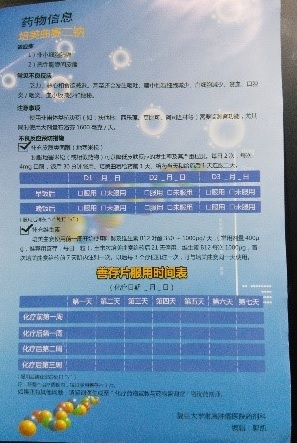Li Huan, Fudan University Shanghai Cancer Center

More and more pharmacists are changing their job focus from dispensing to patient oriented service. Fudan University Shanghai Cancer Center is a specialist hospital, with 1300 beds, and a huge patient volume at nearly 3000 per day. Having nearly 70 patients to see in 3 hours, the doctors are always in a hurry, they have less than 3 minutes to explain to each patient. However, patents are always confused about their regimens and medications, especially for those first visitors. They have thousands of questions but no one to turn to. So, pharmacists started to share the burden of patient education. We have a consulting room next to the intravenous preparation center, where qualified pharmacists work in turns to serve the patients. Pharmacists in the translational department also conduct several patient education projects. Here we share our experience on outpatient education examples.
Paclitaxel premedication

One of the most common questions at outpatient pharmacy is how to duel with so many dexamethasone tablets. Fifty four tablets of dexamethasone are given to patients who are going to receive paclitaxel. 70% of these patients don’t know how to take dexamethasone tablets and why they should take them. We started with calling these patients to check if they know the proper premedication for paclitaxel and encourage them to come to us if they need consultation. During the consultation, we give them education materials (figure) and answer questions on their chemotherapy and other drug-related problems.
C1D1 education of pemetrexed
 Pemetrexed is another drug that needs several pre-medications: oral folic acid 400-1000 mcg beginning 7 days before first pemetrexed dose, intramuscular vitamin B12 1 mg beginning 1 week before first pemetrexed dose and oral dexamethasone 4 mg twice per day for three days. Generally, the hospital pharmacy does not supply folic acid supplements. Patients are told to buy folic acid outside the hospital. In many cases, the patients don’t know which brand to buy and feel confused about the schedule of this medication. So, we started a C1D1 education project of pemetrexed. For each patient who is going to receive their first pemetrexed, we contact them and encourage them to come to us. We give them education materials (figure) and answer drug-related questions.
Pemetrexed is another drug that needs several pre-medications: oral folic acid 400-1000 mcg beginning 7 days before first pemetrexed dose, intramuscular vitamin B12 1 mg beginning 1 week before first pemetrexed dose and oral dexamethasone 4 mg twice per day for three days. Generally, the hospital pharmacy does not supply folic acid supplements. Patients are told to buy folic acid outside the hospital. In many cases, the patients don’t know which brand to buy and feel confused about the schedule of this medication. So, we started a C1D1 education project of pemetrexed. For each patient who is going to receive their first pemetrexed, we contact them and encourage them to come to us. We give them education materials (figure) and answer drug-related questions.
Severe neutropenia education
Severe neutropenia is a dangerous situation for patients undergoing chemotherapy. However, many patients don’t realize the danger of severe neutropenia until they get febrile neutropenia. In this situation, hospitalization or even isolation therapy is often required. So we tried to do something to improve this situation. We check the laboratory test data for the day and select out patients who are in grade 4 neutropenia. We call them or talk to them in person to ask about their health condition and provide pharmaceutical care. We ask whether they know the results and meaning of their laboratory test. We also tell them precaution tips during severe neutropenia, such as temperature monitoring, regular blood tests, avoid public places and so on.
Oral chemotherapy education (lapatinib + capecitabine)
 We have a post-marketing surveillance project on lapatinib. In this pharmacist-led study, trained pharmacists collect patient information, including demographics, medical history, combined medications, adverse events, laboratory results and treatment outcomes. We offer consultation service for the patients in the same time. During the follow-up, we also found that many patients didn’t know the correct schedule of lapatinib. Some took one week break for lapatinib like what they were told with capecitabine. Others complained that sometimes they would forget the week of capecitabine break. We made drug calendars to help them get a better understanding of these two drugs.
We have a post-marketing surveillance project on lapatinib. In this pharmacist-led study, trained pharmacists collect patient information, including demographics, medical history, combined medications, adverse events, laboratory results and treatment outcomes. We offer consultation service for the patients in the same time. During the follow-up, we also found that many patients didn’t know the correct schedule of lapatinib. Some took one week break for lapatinib like what they were told with capecitabine. Others complained that sometimes they would forget the week of capecitabine break. We made drug calendars to help them get a better understanding of these two drugs.
These are some things we tried to do to provide pharmaceutical care in the outpatient setting. Currently, patients don’t need to pay for pharmacy education. By doing these projects, we acumulated practical experience and established a new image of oncology pharmacists. Pharmacists get more familiar with treatment regimens, know more about what patients need, and improve clinical skills. These education projects avoid drug-drug interactions for some patients, make them feel less worried about their treatment and increase patients’ satisfaction.
